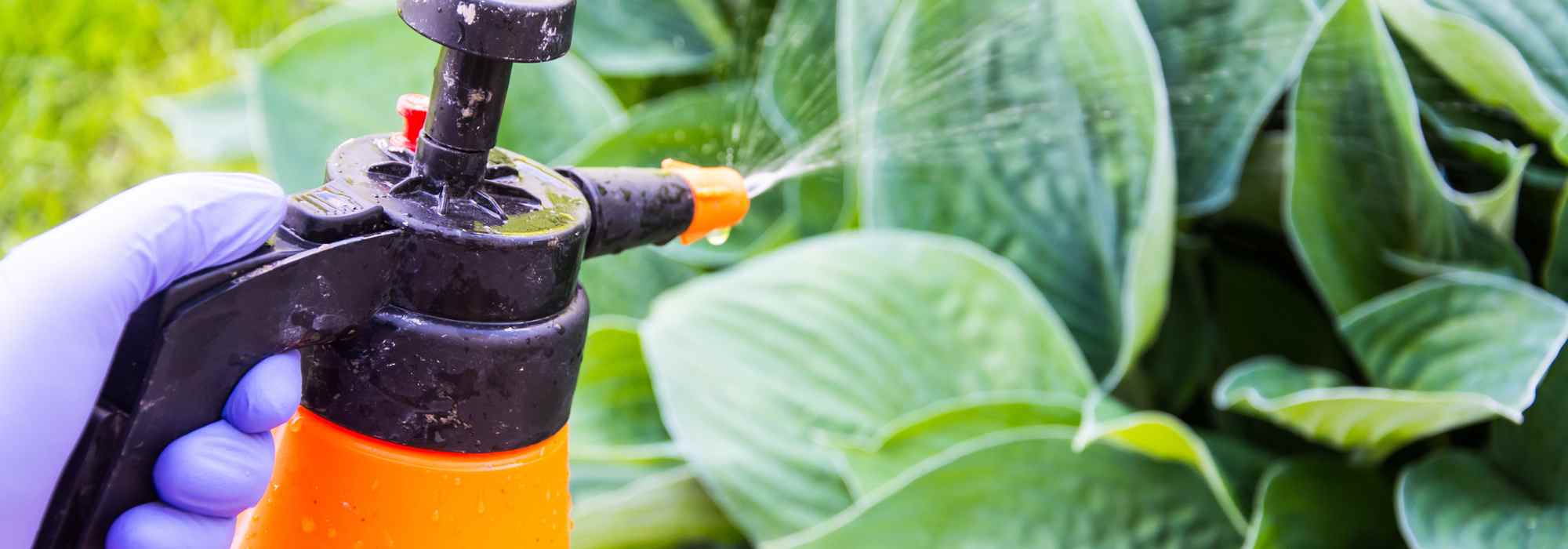
Gardening for beginners: treating and preventing garden plant diseases
All our tips
Contents
When starting out in gardening, one can sometimes feel discouraged by the sight of diseases appearing on their plants: spots, wilting, eaten leaves and other symptoms suggesting that the plant is calling for help.
While each plant has its distinct pests and diseases, this article provides some insights to better understand and address the various ailments affecting plant health.
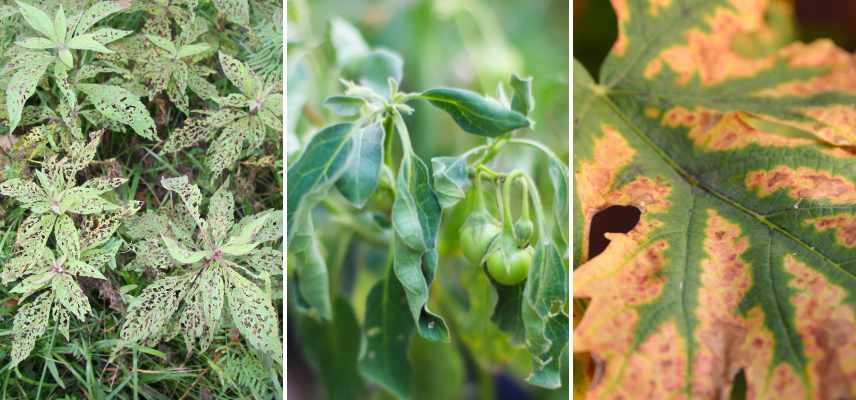
Our plants or vegetables often suffer from the same types of diseases
What can affect a plant?
A sick plant showing symptoms on its leaves, bark, fruits, or flowers is suffering for two main reasons: either it suffers from a fungal disease, or it has been attacked by a pest (usually an insect, in its larval stage, caterpillar, or adult) or, more rarely, by deer, rabbits, as well as slugs and snails.
Here are the recurring cases in a garden:
Common fungal diseases in plants
- Downy mildew : it affects many plants, including tomatoes, potatoes, and vines. It manifests as yellow spots on the leaves, followed by white or grey mould on the undersides of the leaves. Downy mildew thrives in humid and cool conditions.
- Powdery mildew or white disease : it is characterised by a white, powdery coating on leaves, stems, and flowers. It affects a wide range of plants, including roses, squashes, shrubs, or perennials. Powdery mildew often develops in warm and humid conditions.
- Rust : it manifests as orange, yellow, or brown pustules on leaves and stems. It affects many plants, including vegetables and ornamental plants like hollyhocks. Rust spreads through spores and thrives in humid conditions.
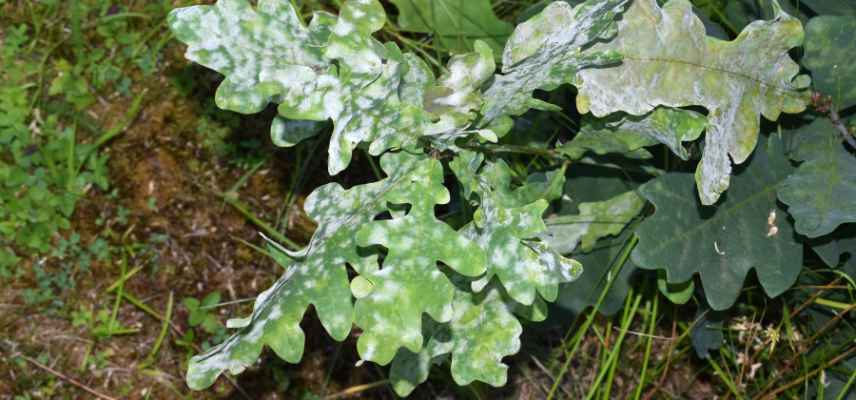
Downy mildew on an oak tree
Main bacterial diseases in plants
These diseases caused by bacteria (known as bacteriosis) can affect a wide range of plants. Symptoms include leaf spots, wilting, cankers, and rots. Bacteriosis often spreads through water, gardening tools, and insects.
Common viral diseases in plants
Viral diseases in plants are caused by viruses that can lead to a variety of symptoms, including leaf mosaics (leaves becoming mottled, in tomatoes, cucumbers, or marigolds), deformations, yellowing, and necrosis. Viruses are often transmitted by insects such as aphids and whiteflies. There is no curative treatment for viral diseases, but appropriate cultural practices help prevent their spread, including systematic disinfection of cutting tools.
Main pests of plants
- Aphids : they can cause leaf deformations, yellowing, and stunted growth. Aphids also excrete a sugary substance called honeydew, which promotes the development of black mould (sooty mould).
- Mealybugs: they are recognised by their cottony, white appearance. Mealybugs can weaken plants and promote the development of fungal diseases. They are often found on stems, leaves, and fruits.
- Thrips: these are small insects that feed on the sap of plants. They can cause leaf deformations, silver spots, and stunted growth. Thrips are often found on flowers, leaves, and fruits. They can also transmit viral diseases.
- Gastropods: slugs and snails, which are much easier to recognise by the slime trails and holes in the plants.
→ Also read our articles: Thrips: identification and natural treatment, Bacteriosis in plants: how to treat and prevent them?
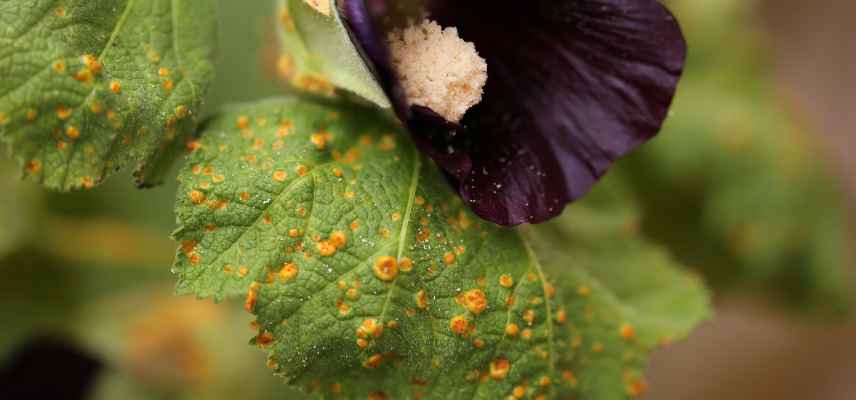 Rust is very common in hollyhocks
Rust is very common in hollyhocks
The main diseases by type of plant: knowing how to identify them
Some diseases regularly recur on specific plant families, which is somewhat helpful when one knows little about parasitology. It would obviously be difficult to list a complete enumeration here, but certain plants are more sensitive to specific diseases. It is therefore interesting to know them to better identify and treat them. Here are the most common in our gardens and vegetable patches:
Diseases of fruit trees
There are many, but they often appear in these forms:
- Scab : especially on apple and pear trees, causing black spots on the leaves and deformed fruit. Horsetail decoction is a good natural remedy.
- Moniliosis or fruit rot, where fruits turn brown and mummified on the tree, with a typical concentric rot. Remove mummified fruits and avoid watering on the foliage.
- Shot hole in stone fruits (peaches and almonds), causing small holes in the leaves, as if they were shot. Collect fallen leaves and treat with copper.
- HLB : the yellow dragon disease currently threatening citrus trees. Leaves yellow in irregular (asymmetrical) areas, green fruits are hard, deformed, and bitter, and flowering is delayed. There is no curative treatment, so it is best to buy certified plants.
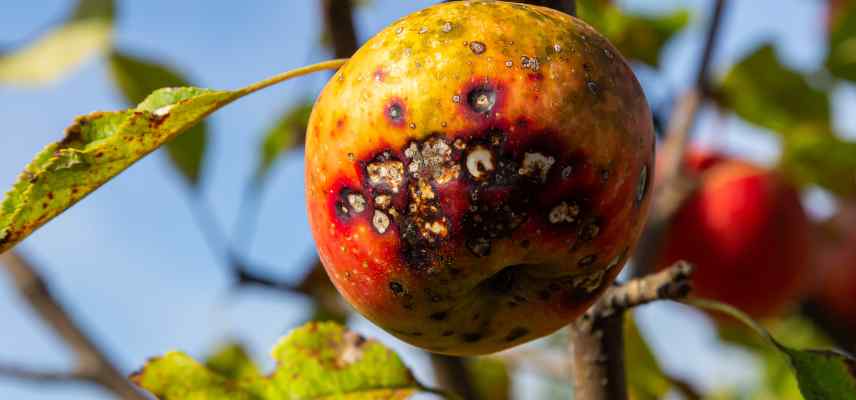 Scab on an apple tree
Scab on an apple tree
Diseases and pests of acidophilous plants
We are talking here about heather soil plants, which need to be planted in acidic soil such as azaleas and rhododendrons, kalmias, Japanese maples…
- Chlorosis: a typical yellowing of the leaves, leaving the veins green, in case of overly calcareous or compact soil. Amend with heather soil and add chelated iron.
- Phytophthora or root rot. Leaves wilt and fall, roots turn black, and the plant dies. Plant in well-draining soil and avoid excessive watering.
- Botrytis (grey rot) especially in hydrangeas and camellias: flowers or buds rot and turn greyish. There is too much moisture in the soil or poor aeration around the bushes.
- Otiorhynchs that perforate the edges of leaves in a semicircle. Laurus tin is also often affected. Read our topic: How to get rid of otiorhynchs?
- Diseases and pests of heathers: they are sometimes subject to radical drying out. Read our article for more details.
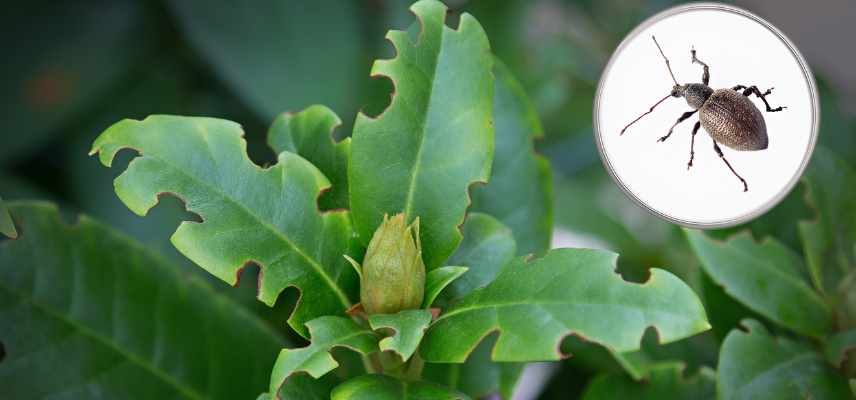 The rhododendron is often a victim of otiorhynchs
The rhododendron is often a victim of otiorhynchs
Diseases of vegetables in the vegetable garden
They are often victims of the powdery mildew when planted too closely and in conditions of heat and humidity. This is particularly the case for cucumbers, courgettes, and many vegetables from the cucurbit family, as well as tomatoes.
Diseases of roses
We often find black spots or rust, powdery mildew, and marsonia on our beloved roses. We present them in detail in our topic on rose diseases, but here are some clues and the recommended treatment:
- Black spots (Marsonia): leaves show rounded black spots, then yellow and fall prematurely. This weakens the plant in the long term. Collect and dispose of fallen leaves, ensure good air circulation around the rose, and apply horsetail manure or Bordeaux mixture preventively at the beginning of the season.
- Downy mildew: brown or purplish spots appear on the leaves, followed by general wilting. The disease develops in humid weather. Remove affected parts at the first signs and treat with horsetail decoction or Bordeaux mixture in case of confirmed attack.
- Powdery mildew (white): a white, powdery deposit covers young leaves and stems. Spray with horsetail manure or a solution of baking soda.
- Rust: it occurs in conditions of stagnant humidity. Small orange pustules appear under the leaves, which eventually yellow and fall. Remove affected leaves and treat with horsetail decoction or Bordeaux mixture, respecting the doses.
 Black spots
Black spots
Diseases of bulbs
Among the “classics”, we often lament the lily beetle, which attacks all lilies. It is a small bright red beetle that perforates the leaves and attacks the flower buds. One must then remove the eggs from under the leaves and collect each adult by hand. But other diseases also affect bulbs, such as bulb rot (which then becomes soft), as well as mainly botrytis or grey rot.
- Bulb fusarium: bulbs turn brown, soft, and dry inside. This fungal disease can persist for several years in the soil.
- Grey rot (Botrytis): bulbs or young shoots become soft, greyish, and then decompose. It mainly appears in wet and poorly drained soil.
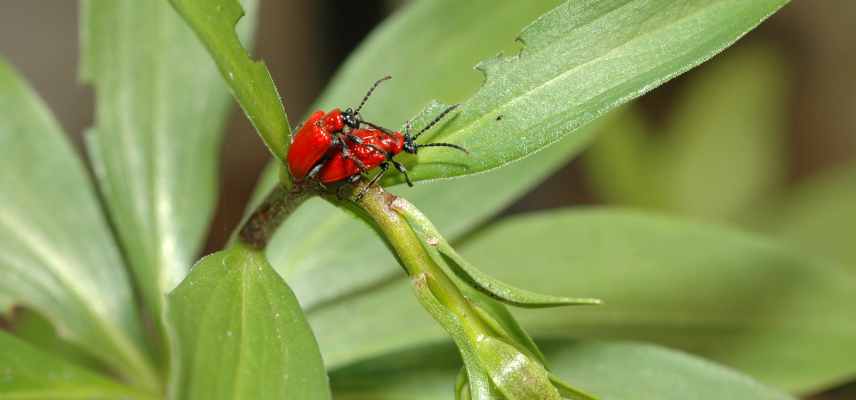 The dreaded lily beetle
The dreaded lily beetle
Diseases of conifers
Conifers (thujas, cypresses, pines…) are quite resistant, but some diseases can affect them, especially in poorly drained soil, notably:
- Branch browning: Branches yellow and then brown, often due to fungi (phytophthora or pythium) related to excess moisture. Improve drainage, avoid excessive watering, and prune affected parts.
- Canker: Wounds or cracks form on the bark, and branches dry out. Remove diseased branches, disinfect tools, and strengthen the plant with manures (horsetail, nettle).
The boxwood
- The boxwood moth, which needs no introduction: a green and striped caterpillar that devours the leaves, weaves webs, and leaves boxwoods completely defoliated. Collect visible caterpillars, spray a treatment based on Bacillus thuringiensis (organic), effective on young caterpillars. Monitor from spring and renew according to package instructions.
- Boxwood disease (caused by the fungus Cylindrocladium): leaves turn brown, fall, and branches decline. Prune diseased parts, ensure good air circulation, disinfect tools, and strengthen with horsetail decoction or Bordeaux mixture as a preventive measure.
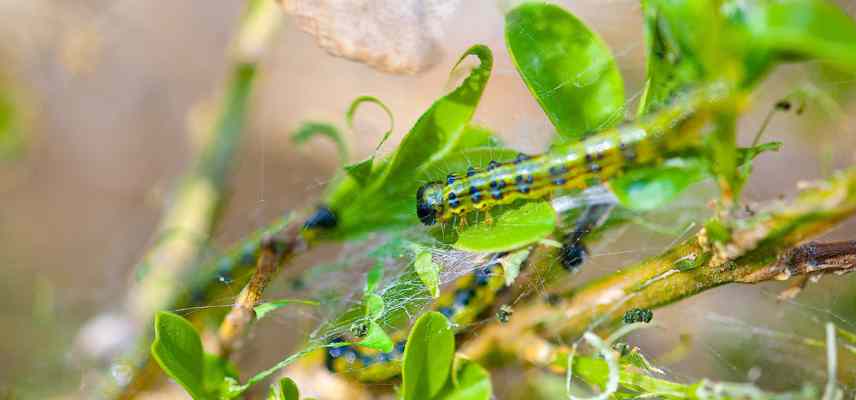 Boxwood moth
Boxwood moth
Disease prevention
Pour garder ses végétaux en pleine santé, prevention is always the best solution and proves invaluable before resorting to any treatment. Une plante bien entretenue sera toujours moins vulnérable aux attaques de maladies et de parasites. Voici quelques conseils précieux à retenir, ils sont la base et valent pour tous les types de plantes :
- Respect the cultural conditions of each plant: suitable exposure, sheltered from strong winds, in deep or poor soil, well-drained or constantly moist. Ces impératifs, s’ils sont respectés, évitent généralement les problèmes de maladie et les carences sur les plantes.
- Adopt good gardening practices: appropriate watering (neither too much nor too little, and without wetting the foliage), sufficient spacing between plants, regular garden cleaning, pruning with always disinfected tools. Enrichissez aussi le sol avec du compost ou du fumier bien décomposé pour améliorer la santé globale de vos plantes.
- Regularly examine the leaves (top and bottom), stems, and buds to quickly detect symptoms of diseases or the presence of pests. Certains ravageurs comme le criocère ne laissent aucun doute. Agissez dès les premiers signes pour limiter la propagation.
- Remove dead branches from trees and bushes to aerate them, improve air circulation, and limit the refuges they represent for pests. Taillez également les parties abîmées par les insectes ou les maladies dès leur apparition. Chez les fruitiers, ramasser les feuilles et les fruits pourris.
- In the vegetable garden, adopt crop rotation: rotate crops by placing them in a different space each year. Cela aide à briser le cycle de vie des pathogènes et des insectes nuisibles. Pascale vous en dit plus dans son article sur la rotation des cultures. Faites aussi grand usage des plantes compagnes qui agissent comme repoussoir (ou plutôt qui attirent les pucerons et autres bestioles, laissant vos légumes tranquilles).
- Apply preventive plant manures: to strengthen resistance to fungi such as powdery mildew, consider horsetail decoctions (rich in silica) or use nettle manure to stimulate plant vigour while repelling certain pests. La macération de camomille booste les cultures et s’utilise fréquemment pour prévenir les maladies fongiques. La macération de fougère, la décoction de pelures d’oignons et la décoction d’ail repoussent quant à elles les insectes nuisibles, agissant comme un répulsif.
- Attract natural auxiliaries: plant melliferous flowers in your garden to attract natural predators such as ladybirds, lacewings or hoverflies, which feed on aphids and other pests. Favorisez également les oiseaux insectivores en installant des nichoirs, mais aussi des abris à chauve-souris, véritables alliées elles aussi.
- Stimulate the natural defences of potted plants: fertilise them regularly with suitable fertiliser to promote their growth and strengthen their defences.
- Finally, select disease-resistant plants. There are many trouble-free plants! Avoid problem plants as much as possible, as mentioned above.
→ Read also Biological control in the garden and vegetable garden: auxiliary insects. and our complete section on auxiliary insects and manures, decoctions, and macerations.
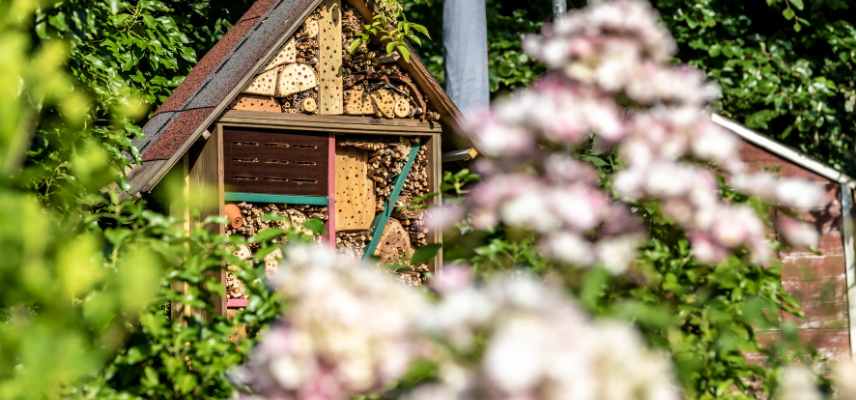
Un jardin où la biodiversité est reine est moins sensible aux maladies
Effective natural treatments when the disease is established
When your plants show clear signs of disease, it is important to act quickly to limit the damage. Here are some treatment methods you can use. We recommend these organic solutions to avoid harming beneficial organisms and to preserve the ecosystem in the garden. Among the natural solutions available to you to limit damage and slow the spread:
Natural fungicides
-
Bordeaux mixture (copper-based): used sparingly, it remains effective against downy mildew, peach leaf curl, and grey rot. However, it should be reserved for declared cases, never for systematic preventive use to preserve the soil.
-
Horsetail decoction: it strengthens plants and slows the development of fungi (powdery mildew, downy mildew).
-
Nettle extract or comfrey extract: they stimulate plant defenses and limit fungal attacks. Lavender extract also acts as an insecticide and parasiticide against aphids, mealybugs, and ants.
- Baking soda: it is useful against mild fungal diseases such as powdery mildew or certain leaf spots. Instructions: mix 1 tablespoon of baking soda in 1 litre of water, add 1 teaspoon of liquid black soap, then spray on both sides of the leaves. Repeat this treatment every 7 to 10 days.
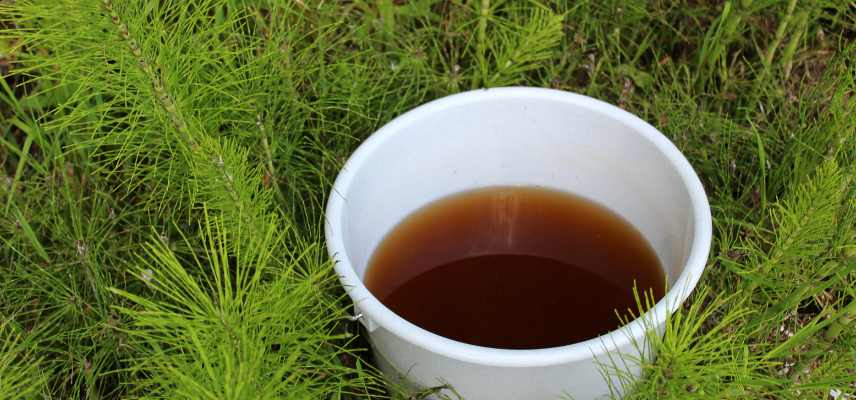 Horsetail extract
Horsetail extract
Natural insecticides
-
Black soap: to control soft-bodied pests such as aphids, mealybugs, and whiteflies, on which it is very effective. It can also be used on thrips. It works by suffocating the insects and disrupting their cell membranes. Mix 1 tablespoon of liquid black soap, 1 tablespoon of 90° alcohol, and 1 tablespoon of neutral oil (such as sunflower or rapeseed oil) in 1 litre of warm water. Spray generously on the leaves, as well as on the stems and buds.
-
Neem oil: versatile, this natural insecticide and fungicide of plant origin can be used to treat many insects and diseases. Mix neem oil with water (dilution of 5 to 10 ml of pure neem oil in 1 L of warm water, and ideally a few drops of black soap to improve adherence), to be sprayed on the affected parts.
- Pyrenthrum: this is a natural insecticide, extracted from pyrethrum flowers (chrysanthemum). Very effective against insects (aphids, whiteflies, thrips), but should be used sparingly, only in cases of heavy infestation, as pyrethrum also kills beneficial insects (ladybugs, bees). Treat in the evening, when pollinators are no longer flying, and target only the infested areas. For more information, see our sheet: Using pyrethrum in the garden.
Biocontrol methods
They involve microscopic organisms that are true natural parasites of many insects, including vine weevils and certain caterpillars. Read: How to combat white grubs using nematodes?
-
Entomopathogenic nematodes: they are effective against white grubs, vine weevils, and certain soil pests.
-
Introduction of beneficial organisms: ladybugs and lacewings are often essential as a complement. You can also install nesting boxes to attract insectivorous birds.
IMPORTANT: Even though they are natural, all these treatments should be used judiciously to preserve the balance of the garden. Always start by strengthening the plant and limiting hotspots (pruning, cleaning) before treating. Preferably treat in the morning or late in the day, never in full sun to avoid burns, nor just before rain, which would render these products ineffective. All these natural treatments should be repeated every 7 to 14 days until symptoms disappear.
- Subscribe!
- Contents
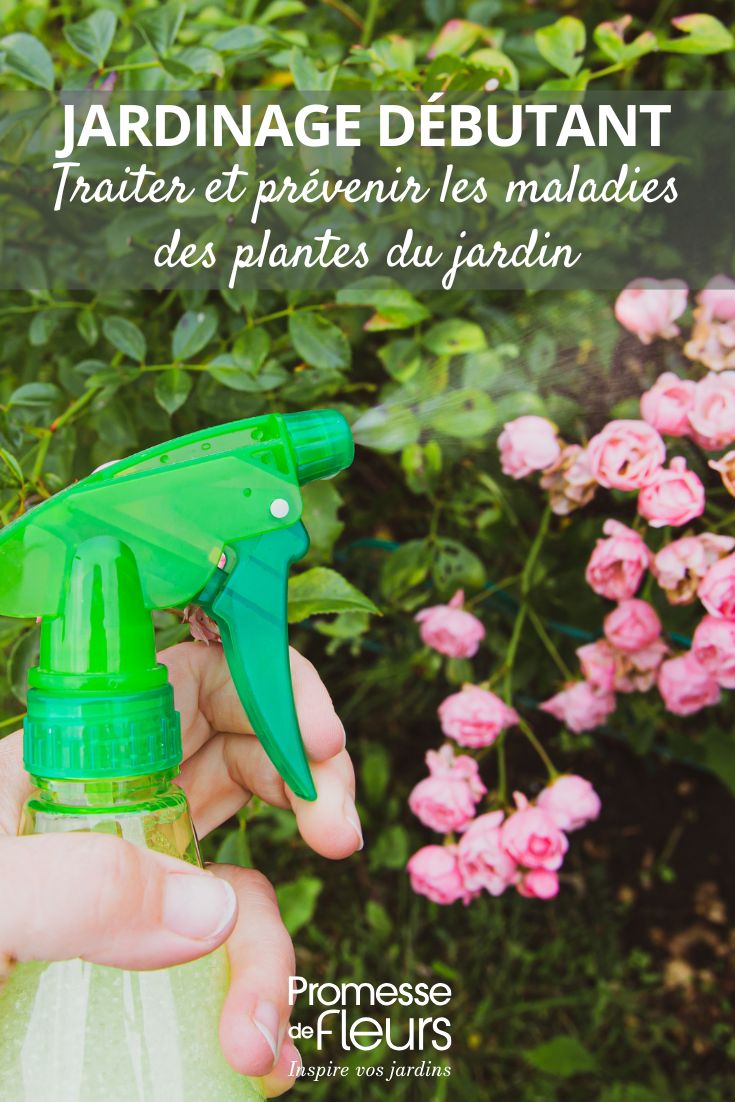































Comments